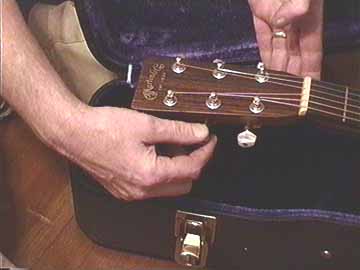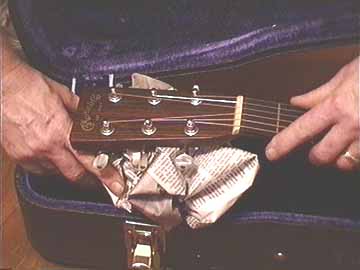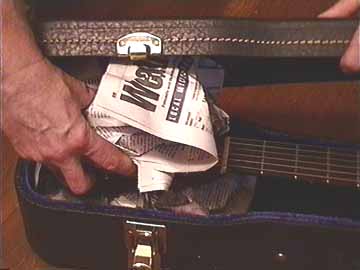Page 1 of 2
I'm gonna
Pack Up My Old Guitar. . .
© Frank Ford, 5/1/98; Photos by FF, 4/30/98
OK, you've got a good hardshell case.
You do have a hardshell case, don't you? If you want to travel and you
don't have a hardshell case, then get one!
Now that we've gotten that out of the way, let's talk about traveling with your instrument.
Because guitars are so popular, I'll use "guitar" to mean "instrument"
in the generic sense.
We talk about the dangers of humidity and heat, but if there's
one phrase that strikes terror in the hearts of guitar players, it's "airline
baggage handlers." Rightly so, because these guys are under a lot of pressure
to get the baggage moved quickly, and they tend to toss suitcases and guitar cases
with apparent abandon. They're really just doing their jobs, and most of the time
the bumps and scrapes are truly just normal wear and tear, but. . .
There's nothing like the sight of your guitar being pitched straight down to the
tarmac from the belly of an aircraft!
Bear in mind that the vast majority of the time instruments and baggage come through
the journey without a scratch. Once, I saw a 'cello dressed only in a flimsy canvas
bag come bouncing down the baggage chute onto the carousel. Its owner claimed it,
opened the bag, looked it over and played a few notes to prove that it was in fine
shape. I would have predicted certain disaster, about like shipping an ostrich egg
with no packaging.
The real issue to protect yourself and your guitar from the trauma
of being one of the casualties. I think it's wise to consider checking an instrument
through the baggage system to be basically the same as shipping it by UPS or other
carrier.
Once I saw a guitar that had been speared by the tines of a forklift. I really don't
think it's reasonable to try to guard against that kind of freak accident.
The real danger is from the kind of normal fall that baggage takes when it gets dropped.
In that kind of fall, the case may not be damaged, but the guitar inside can really
get crunched.
There's not a lot you can do to protect your guitar if the case gets squished, but
that circumstance is also very rare. What's not rare is a flat fall in which the
neck breaks right behind the nut. The case hits the ground with a sharp blow, and
the peghead snaps the neck in a classic "whiplash" injury. The grain direction
of the neck is usually rather unfavorable for such an impact, and the tuners add
a lot of mass. The inertia of the peghead may snap the neck in either a forward or
backward fall.
By the way, the super heavy "flight cases" give great protection, but not
from the inertial blow I'm discussing here. If I had one of these cases, I'd pack
the peghead the same way as I'm describing.
For years, I've packed guitars with little or no additional support for the body,
concentrating all my effort on packing the peghead to avoid what we call the "airline
break."
I hope it's obvious that my packing instructions also apply to shipping guitars by
common carrier.
Now, let's travel:
First, I like to loosen the string tension:

I don't think it's necessarily a good idea to release all the tension on a steel
string guitar. Leaving some tension will support the peghead a little in a backward
fall; it will also keep the bridge pins in place. For steel string guitars I detune
the strings nearly but not completely slack. I'd leave a nylon string guitar tuned
up because the tension is not so great.
If your guitar has a pickup and preamp installed, remove the battery and wrap it
up inside the string pocket of the case. If it gets loose, a battery can do a lot
of damage flying around inside a guitar body.
Arch top guitars, mandolins, and instruments with moveable bridges should have the
bridges, tailpiece covers and any other parts that could come loose removed, wrapped
securely and stowed in the string compartment of the case. Remember that these little
guys will get loose if they can, and scar the hell out of your instrument!
If the strings lie directly on the face of the instrument after removing the bridge,
then I'll wrap the strings in a paper towel to avoid scratches.
Next, a big wad of newspaper under the peghead:

This is enough paper to hold the peghead high in the case.
When it comes to balling up newspaper, I've found that it's better to use about
3 sheets at a time rather than just one. The resulting wads have greater strength
for packing.
Then, a similar stuffing on top of the peghead:

How much stuffing?
Enough so it's plenty hard to close the case, with the peghead suspended, equally
supported on top and bottom.
I'm pushing hard to close this case:

The idea is to keep the peghead from moving even a teeny bit when the guitar case
gets slammed down.
Time for a couple more anecdotes:
Years ago I had a customer leave his guitar case standing on its butt end with
the neck sticking straight up in the air. Just as I warned him, the case fell flat
forward on its face. When he opened it up, the peghead had snapped clean off! This
was a good illustration of how simple a fall can cause great damage. A flat fall
on the carpeted floor caused no damage to the case, of course, but delivered a huge
blow to the peghead.
After hearing my description of how to protect the peghead, one fellow packed his
guitar's peghead with a light polyurethane foam wedge on top and bottom. The peghead
was broken during handling by the airlines. Clearly, the foam was not rigid enough
to prevent a slight movement when the case hit the deck.
Bubble wrap is OK, but you've got to make sure you use enough to
keep that old inertia in check:

Again, this case will be hard to close before I'm through!
As to the body, I don't do anything except make sure it doesn't rattle around. I've
never seen inertia injure the body without collapsing the case. Oh, yes, and remove
the end pin if you can, especially if it butts up against the case. Lots of cases
are relieved in that area and padded to avoid driving the end pin into the body.
Naturally, it doesn't hurt to put some soft resilient padding around the body anywhere
you can, but usually I don't find it necessary.
Here's an important caution:
Many fine instruments are finished with French polish or nitrocellulose lacquer.
Particularly when the finish is relatively new, it may react to packing material,
case lining, straps, tape, etc. When packing up you may want to protect the finish
from what appears to be innocent resilient packing material.
Crunched up newspaper has corners that press into finish, and bubble wrap has bubbles
that press unevenly, so you can wrap the peghead in plain paper to equalize the pressure
and keep volatile plastics away from a delicate finish.
By the way, I have never seen (but I have heard of) damage to old finishes
from bubble wrap and newspaper. I have, however, seen lots of new instruments
that were shipped from their makers a bit too soon after the finish was applied.
These often get press marks deep into the uncured finish from the case lining
and/or packing material.
More
1
2
Back to Index Page